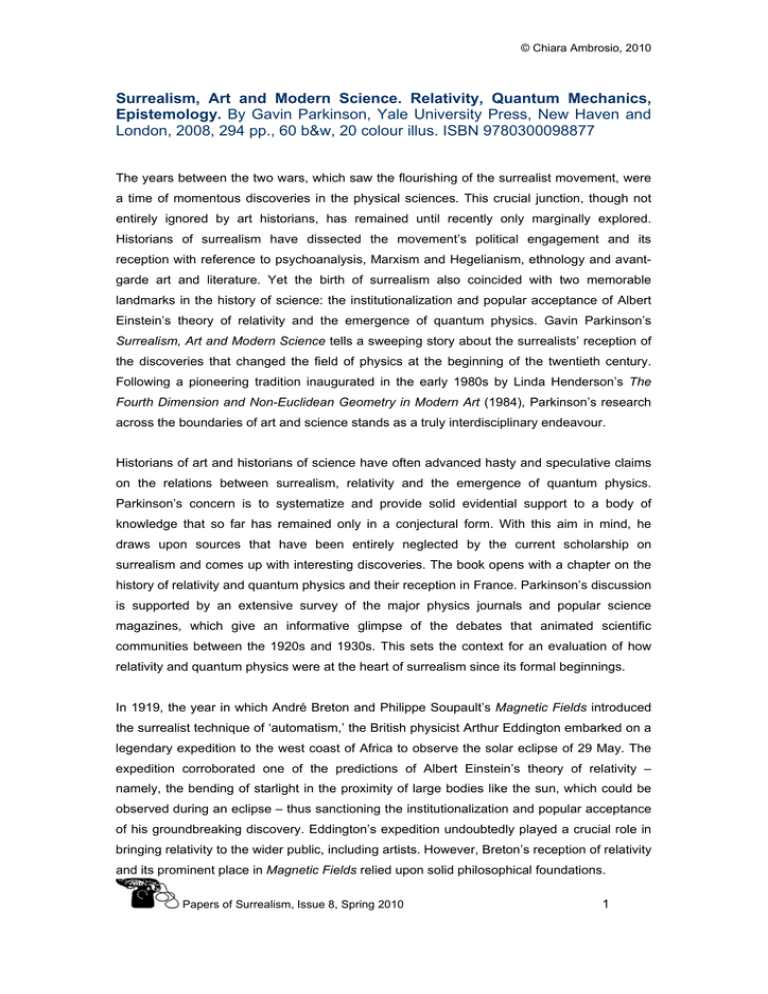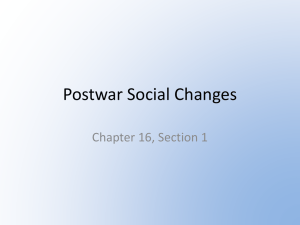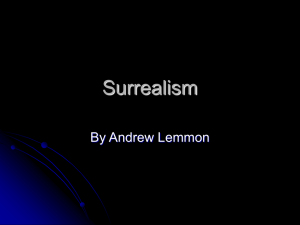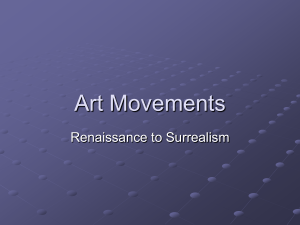Surrealism, Art and Modern Science. Relativity, Quantum Mechanics
advertisement

© Chiara Ambrosio, 2010 Surrealism, Art and Modern Science. Relativity, Quantum Mechanics, Epistemology. By Gavin Parkinson, Yale University Press, New Haven and London, 2008, 294 pp., 60 b&w, 20 colour illus. ISBN 9780300098877 The years between the two wars, which saw the flourishing of the surrealist movement, were a time of momentous discoveries in the physical sciences. This crucial junction, though not entirely ignored by art historians, has remained until recently only marginally explored. Historians of surrealism have dissected the movement’s political engagement and its reception with reference to psychoanalysis, Marxism and Hegelianism, ethnology and avantgarde art and literature. Yet the birth of surrealism also coincided with two memorable landmarks in the history of science: the institutionalization and popular acceptance of Albert Einstein’s theory of relativity and the emergence of quantum physics. Gavin Parkinson’s Surrealism, Art and Modern Science tells a sweeping story about the surrealists’ reception of the discoveries that changed the field of physics at the beginning of the twentieth century. Following a pioneering tradition inaugurated in the early 1980s by Linda Henderson’s The Fourth Dimension and Non-Euclidean Geometry in Modern Art (1984), Parkinson’s research across the boundaries of art and science stands as a truly interdisciplinary endeavour. Historians of art and historians of science have often advanced hasty and speculative claims on the relations between surrealism, relativity and the emergence of quantum physics. Parkinson’s concern is to systematize and provide solid evidential support to a body of knowledge that so far has remained only in a conjectural form. With this aim in mind, he draws upon sources that have been entirely neglected by the current scholarship on surrealism and comes up with interesting discoveries. The book opens with a chapter on the history of relativity and quantum physics and their reception in France. Parkinson’s discussion is supported by an extensive survey of the major physics journals and popular science magazines, which give an informative glimpse of the debates that animated scientific communities between the 1920s and 1930s. This sets the context for an evaluation of how relativity and quantum physics were at the heart of surrealism since its formal beginnings. In 1919, the year in which André Breton and Philippe Soupault’s Magnetic Fields introduced the surrealist technique of ‘automatism,’ the British physicist Arthur Eddington embarked on a legendary expedition to the west coast of Africa to observe the solar eclipse of 29 May. The expedition corroborated one of the predictions of Albert Einstein’s theory of relativity – namely, the bending of starlight in the proximity of large bodies like the sun, which could be observed during an eclipse – thus sanctioning the institutionalization and popular acceptance of his groundbreaking discovery. Eddington’s expedition undoubtedly played a crucial role in bringing relativity to the wider public, including artists. However, Breton’s reception of relativity and its prominent place in Magnetic Fields relied upon solid philosophical foundations. Papers of Surrealism, Issue 8, Spring 2010 1 © Chiara Ambrosio, 2010 Parkinson suggests that one of Breton’s early sources was Paul Valery, his mentor between 1914 and 1921. Valery had been especially sensitive to the latest developments in physics. He frequently visited laboratories and fostered friendships with eminent scientists such as Niels Bohr, Jean Perrin, Paul Langevin and Louis de Broglie. Another influence on Breton’s understanding of scientific themes was the philosopher of science (and former physicist) Gaston Bachelard. Anticipating ideas that Thomas S. Kuhn would develop only three decades later in The Structure of Scientific Revolutions (1962), Bachelard’s The New Scientific Spirit (1934) revolved around a non-linear conception of scientific change. Drawing on a dynamic view of the history of science (another common point between Bachelard and Kuhn), he characterized scientific change in terms of breaks and revolutions, with new ideas ‘enveloping’ and replacing old ones. Through a meticulous textual analysis, Parkinson shows that Bachelard’s scientific epistemology and his ‘open rationalism’ informs Breton’s ‘Crisis of the Object’ (1936), published only two years after The New Scientific Spirit. In the third chapter of his book, Parkinson revisits a topic with which art historians are well acquainted: the relations between surrealism and politics. He insightfully shows that the surrealists’ political agenda was deeply intertwined with the active engagement in public affairs of left-wing physicists such as Jean Perrin and Paul Langevin, who played a crucial role in securing state funding for scientific research under Léon Blum’s government. Another route that allowed the coming together of surrealism, physics and politics was the single-issue journal Inquisitions (1936). Born to spread the ideas of the Groupe d’Études pour la Phénoménologie Humaine established by Tristan Tzara, the journal’s political and pedagogical mission was to bring the new physics to the masses. The issue featured five theoretical articles, three of which addressed scientific themes. Jacques Spitz’s ‘Quantum Theory and the Problem of Knowledge’ delved into the epistemological implications of de Broglie’s wave/particle duality and Heisenberg’s uncertainty principle. Roger Callois’s ‘For a Militant Orthodoxy: The Immediate Task of Modern Thought’ turned to science as a binding social force at a time in which myths could no longer fulfil this task. Gaston Bachelard’s ‘Le Surrationalisme’ invoked an active engagement of human reason by conjoining surrealism with the most radical and innovative aspects of the new physics. Sir Arthur Eddington was among the scientific figures that affected surrealism most. In chapter four, Parkinson presents his works on celestial mechanics in an entirely new light, which will excite historians of science and historians of art alike. The British astrophysicist is often portrayed as a sober quack bachelor whose life was entirely devoted to science – a characterization that sharply contrasts with the lively iconoclasm of the surrealists. Yet, Eddington’s remarkable talent for storytelling resulted in poetic explanations of complex scientific concepts, which often incorporated sophisticated literary quotations from Papers of Surrealism, Issue 8, Spring 2010 2 © Chiara Ambrosio, 2010 Shakespeare, Lewis Carroll and Jonathan Swift. This aspect of his work fired the surrealists’ imagination and compelled Breton to qualify him as one of the British precursors of surrealism. Eddington’s studies in celestial mechanics found a literary echo in George Bataille’s 1938 text ‘Celestial Bodies.’ Despite the Nietzschean flavour of Bataille’s imaginative vision of the workings of celestial bodies, Parkinson regards the mystical connotations of the text as complementary to Eddington’s own mystical inclinations, thus offering an innovative conciliatory portrait of their views. Parkinson returns to quantum physics in chapter five, where he evaluates Wolfgang Paalen’s reception of the puzzling wave/particle duality – the idea that light and matter exist as waves and particles at the same time. Paalen’s 1940 Figure Pandynamique is regarded by Parkinson as a case in point. The painting attempts to capture the wave/particle duality by depicting it as a set of repeating rings culminating in spheres. Whether Paalen was successful in his attempt is open to question. Figure Pandynamique openly challenged Werner Heisenberg’s notorious rejection of imagery to describe subatomic phenomena. Indeed, Parkinson stresses that Paalen’s works were influenced by the opposite stream in quantum physics, headed by Erwin Schrödinger and Louis de Broglie, who persisted in their search for an imagery-based description of subatomic phenomena. The chapter ends with an interesting section illustrating that surrealism, via quantum physics, incorporated theoretical ideas from Logical Positivism. Parkinson develops this theme in an original way, and yet he does not seem to make the most out of this truly intriguing connection. The book’s interdisciplinary take on the Vienna Circle certainly contributes to defy the standard portrait of its members as conservative science-worshippers – a view that dominated philosophical discussions until recently. Yet, Parkinson overlooks the fact that the philosophy of the Vienna Circle revolved around an ideal of intellectual flexibility and pluralism which had strong social and political connotations. Rudolf Carnap’s ‘principle of tolerance’ allowed for a plurality of logics in analogy with non-Euclidean geometries. Similarly, Otto Neurath’s defence of political pluralism linked political tolerance to the epistemic pluralism that characterized logical empiricism. A study of the surrealist reception of this little-explored aspect of Logical Positivism has much to offer to philosophers of science and art historians, and might disclose new pathways of inquiry into the relations between twentieth-century art and philosophy of science. The final two chapters discuss Salvador Dalí’s spectacular fusion of relativity and psychoanalysis, which found its ultimate expression in the 1931 canvas The Persistence of Memory. By placing Dalí’s works in dialogue with Roger Callois’s science-inspired writings, Parkinson explores the resurfacing of relativity in surrealist art and theory in the 1930s. Both Dalí’s delire and Callois’ rigueur are best understood against the backdrop of their Papers of Surrealism, Issue 8, Spring 2010 3 © Chiara Ambrosio, 2010 (undoubtedly different) ways of understanding and representing concepts in modern physics. The book concludes with a ‘coda’ portraying the surrealists’ changing attitudes towards science after World War II and in the nuclear age. While Dalí never recanted his firm beliefs in the virtues of modern physics, the movement’s disenchantment with science was bitterly expressed in a 1952 interview by Breton, which marked the ending of the love affair between surrealism and science. In the introduction, Parkinson promises his readers the first comprehensive history, analysis and interpretation of the relations between surrealism and physics. In this, the book proves successful. Non-expert readers might be occasionally distracted by his sophisticated prose – a feature that is at odds with the clarity of exposition that characterized the works of the scientists discussed in the book. Philosophers of science, on the other hand, will be puzzled with the rather vague notion of epistemology that recurrently emerges from the discussion, and perhaps will demand that epistemological issues find a more solid grounding in the metaphysics of the new science. Despite this, Parkinson’s effort to engage with complex scientific concepts – a task that would terrify most art historians – provides a refreshing interdisciplinary perspective on one of the most debated movements in contemporary art. In this respect, Surrealism, Art and Modern Science will certainly open novel and promising paths of investigation into the complex and fascinating relations between art and science at the beginning of the twentieth century. Chiara Ambrosio University College London Papers of Surrealism, Issue 8, Spring 2010 4





